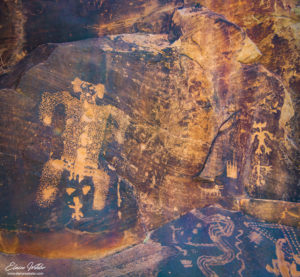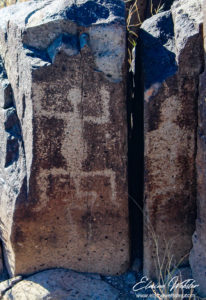Been traveling lately through time and space—in a way that comes with birth and re-birth. Scientists, scholars, and such seek many of the same answers that I pursue unscientifically. Bottom line? No absolutes and I’ll go with my gut.
Of all the common scenes depicted by petroglyphs worldwide, the birthing scenes are intriguing, especially in the southwestern United States. I recently photographed two such scenes in Arizona (near Holbrook at Rock Art Ranch) and in New Mexico (Three Rivers Petroglyphs near Tularosa). At first glance the obvious difference is the arm structure—one with arms upward (Three Rivers) and the other with arms down (Rock Art Ranch). The Arizona version has Hopi-like hair whorls, which would suggest some Hopi connection. The distance between the two sites is over 350 miles.
The Three Rivers site suggests chaos—rocks turned and spewed every which way—as if giant winds, volcanic activity, or water broke them apart after they were inscribed. However, today, the site feels safer and maybe newer.
The Rock Art Ranch site, to be honest, gave me the willies. I was fascinated with the Hopi ceremonial site, the nearby pit houses, the female exclusive sweat lodge, the men’s prayer hogan, and of course, the beautifully displayed and unique pottery— until we descended towards the canyon. This is a place where pure water runs year-round, and flash flood advisories are taken seriously. When the ranch gets a call from the rangers who work the higher elevations, that a flood is coming, the water descends with the sound of a freight train, flooding the canyon and filling it to the brim. I wondered how many have tragically died here.
This region including Chevelon and Gear Creek known as the Palavayu was first inhabited during Paleo-Indian times around 9500 B.C. and subsequently occupied by Archaic, Basket maker and Pueblo groups until at least A. D. 1450. That’s a long time, in a harsh and almost uninhabitable area. Water was the main draw, but remarkably, although pottery shards are strewn all around the nearby pit houses and beyond, no pottery has been found in the canyon, suggesting that the art may not have been done by the locals.
(For a scientific conclusion, check out this 1999 research paper Kolber Article:
Variations Of Human Figures Through Time And Space At Baird’s Chevelon Steps
Jane Kolber, Rock Art Field School Director,
Arizona Archaeological Society Instructor, Cochise College Kolber Article
My unscientific view is that these “news” sites have a vibrational meaning. Yes, they tell stories, but they also depict other-worldly vibrations, links (possibly vortexes in nature), and energy exchanges, often added to over time. I also think that they’re linked to places of emergence or transition. In this case, this site is directly connected to the place that Hopis believe to be their place—the convergence of the Colorado and Little Colorado rivers in the Grand Canyon. Specifically, the water of the Little Colorado River spills into the water of the Colorado River and the Little Colorado eventually drains into northern Arizona’s Painted Desert where Rock Art Ranch is located.
I can’t put my finger on this feeling of mine–that there’s something sacred and very different at both sites. Once again, the arm placement of the two birth scenes feel as if they represent new hope and at the same time warn us about the fragility of life. At the Three Rivers site, I feel that it might have been a place to wait, much like an airport terminal, or bus station where strangers greet and meet—awaiting the next journey. The female figure is reaching to the sky in prayer as she births the next generation. At the Rock Art site, I feel warnings. The female giving birth, is large and stronger looking. Her arms are down as she pushes with great effort to birth the next generation. Life is hard here, dangerous, and her downward arms for me, feel like a warning—i.e. complete what you need to do here, then leave. Anyway, that’s my take.
While both my husband, Blake and I are drawn to the Three Rivers site; something happened to us at Rock Art Ranch. As I’ve previously explained in various posts, we believe in Divine guidance, inspiration, and intervention. Blake had an accident, which left him bruised and battered. He’ll be okay, but as I watched him fall, as the two nurses that also took the tour examined his head, I felt as if this was a wake-up call of some kind. I felt blocked, could barely focus on what happened and feared that when he raised his head, that there might be a pool of blood. Thankfully, there wasn’t. Afterward, after some rest and first aid, we did go down into the canyon. I got down okay but froze at the bottom—unable to venture the quarter mile that leads to a small pool. Blake went around the bend, but no further. He too felt stopped and since he had fallen once, thought it a good idea to leave. There’s no definite conclusion to this episode, but two weeks later, neither of us has felt comfortable about what occurred—almost like we received a warning of some kind.
O’boy, then, the fire and windstorms started, engulfing Northern New Mexico. The trip home felt as if we were driving through all the earth changes, all at once. And as I type, the entire state is on high fire alert with many acres burning, in what has been reported as the largest current fire in the country.
Okay, so what does it all mean? Well, we feel like we were intentionally moved to a place of safety in Southern New Mexico. We are fire alert and windy, but overall safe from disastrous conditions. We watch the weather daily and the scary stuff seems to curve up and away, much to the detriment of the states to our east. Tornadoes, hurricanes, earthquakes, too much rain, too little rain, maybe an earth axis shift? These are all predicted by many indigenous peoples, especially the Hopis. I like to think that it is a transition, and all will be eventually well. But it’s going to be a bumpy ride, so buckle your seatbelts, keep the faith, love those that you can, and above all else, be kind to yourself and others. Aum.
ShareMAY
2022

About the Author:
Elaine Webster writes fiction, creative non-fiction, essays and poetry from her studio in Las Cruces, New Mexico—in the heart of the Land of Enchantment. “It’s easy to be creative surrounded by the beauty of Southern New Mexico. We have the best of everything—food, art, culture, music and sense of community.”